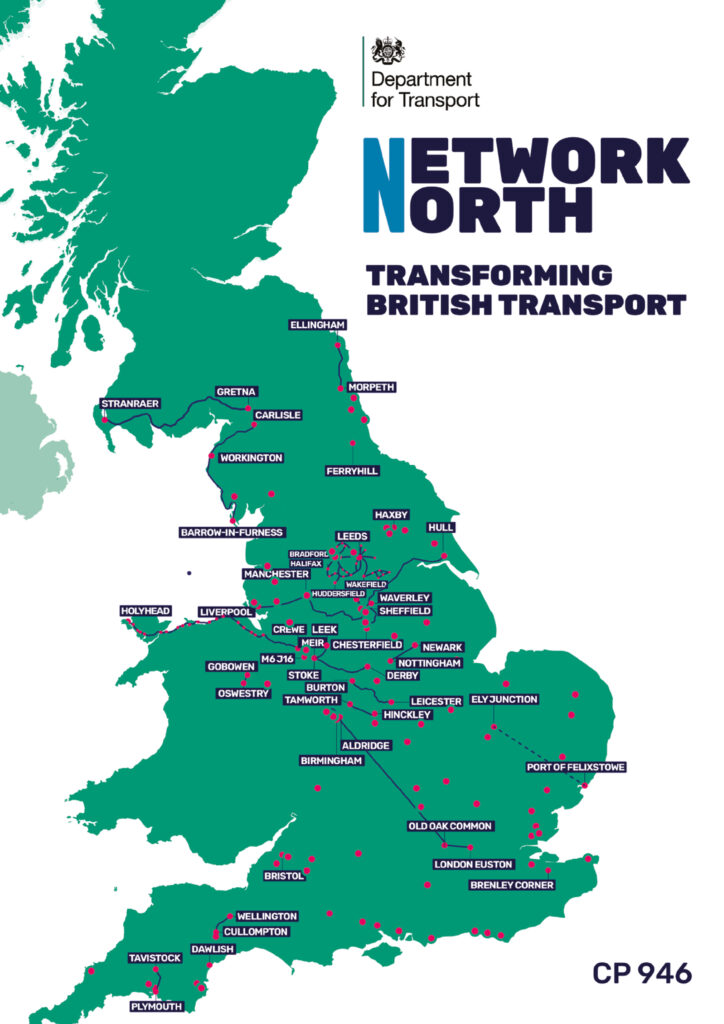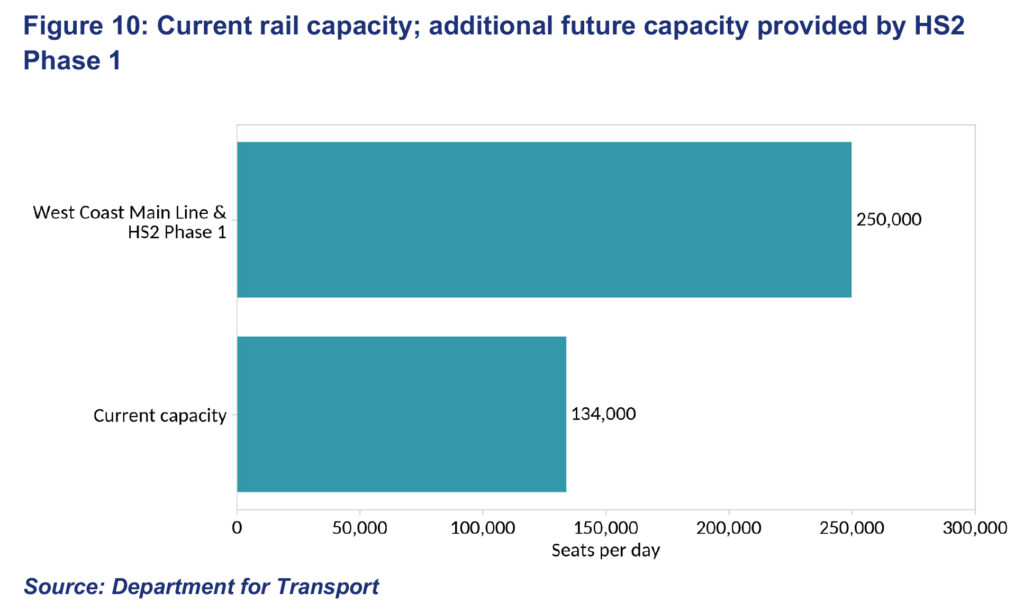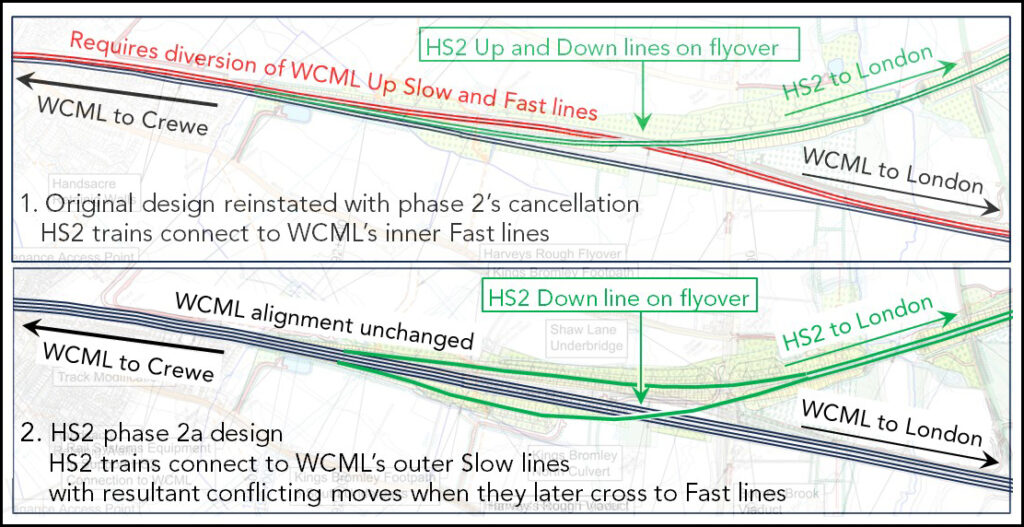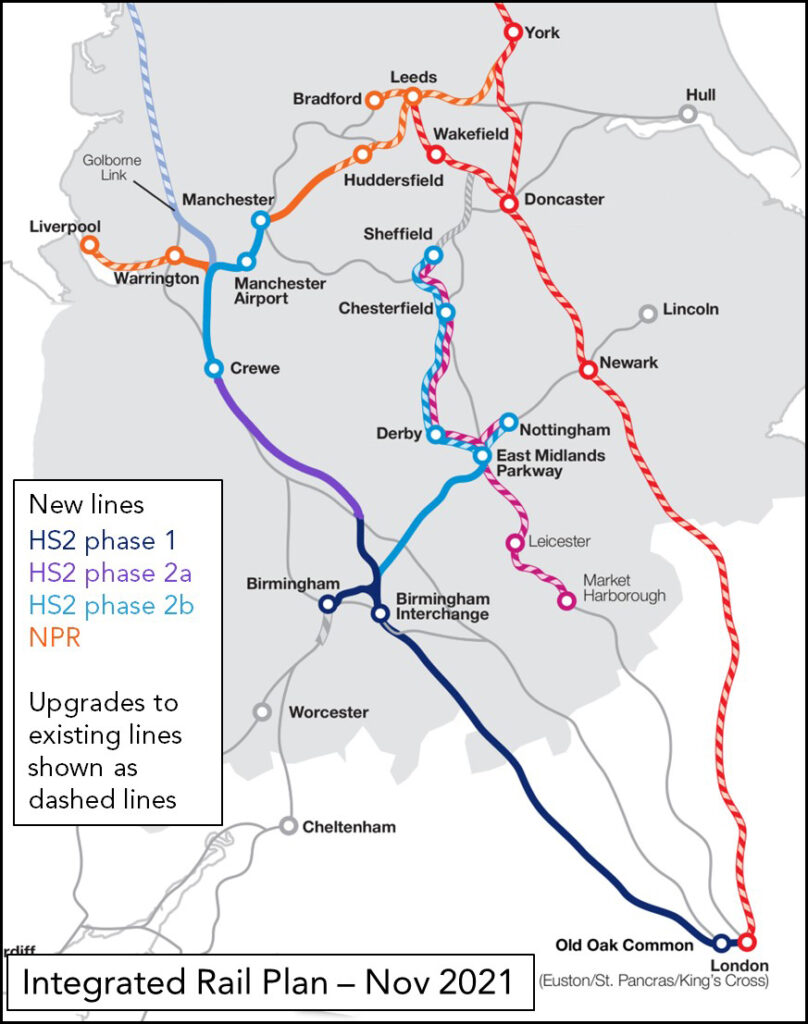The only parts of HS2 now certain to be built are from Old Oak Common to Birmingham and Handsacre Junction on the West Coast Main Line (WCML). When announcing his decision to cancel HS2 phase 2 and replace it with Network North, Prime Minister Sunak gave an assurance that HS2 would terminate at Euston. However, it now seems that this promise depends on securing sufficient private investment.
Curtailing HS2 was a decision of huge magnitude. The HS2 Y network from London to Manchester and Leeds, and its trains, were designed as a fully integrated system. Hence permanently curtailing the network to its trunk line has significant adverse consequences.
These consequences are now becoming clearer, partly from the Parliamentary Transport Committee (PTC)’s HS2 update session on 8 November, when witnesses included Andrew McNaughton (AMcN), HS2’s chief engineer then technical director from 2012 to 2018, and Richard Bowker (RB) who was CEO of the Strategic Rail Authority which rescued the West Coast Route Modernisation project.
Capacity
Part of the case for curtailing HS2 was passenger numbers not returning to their 2019 pre-Covid levels. Yet the 1.4 billion rail passenger journeys in 2022/23 were 10% more than those in 2009/10 when HS2 was initiated. At the PTC, RB advised that, on the West Coast Main Line (WCML), Virgin trains passenger numbers increased from 11 million to 40 million in the 20 years since 1997.
AMcN noted when HS2 was initiated, the WCML was expected to run out of capacity in the mid-2020s. Though Covid was a shock, against an underlying long term trend, its effect is delaying WCML running out of capacity to 2030.
RB advised that, between Lichfield and Crewe, WCML is already at capacity with 13 train paths: Manchester (3); Liverpool (2); Preston & Glasgow (2); Chester (1); West Midlands Trains (1); and Freight (4). HS2 phase 2a from Handsacre Junction to Crewe would have by-passed this section to allow more trains to run, particularly freight trains. It would have also offered more trains on the Manchester to Birmingham corridor.

HS2’s train frequency is determined by the capacity of its London terminal station. RB advised that Old Oak Common could reliably operate six to eight trains per hour and that the current plan is for seven trains per hour. He considered a lot of people would be penalised if this became HS2’s London terminus.
Both RB and AMcN considered that a six-platform HS2 Euston station could operate 10 trains per hour provided that there was grade separation between departing and arriving trains. AMcN considered that, to ensure a reliable service, there should be a seventh platform to accommodate any failed trains.
In his statement to Parliament about the HS2 cutback, Transport Minister Mark Harper claimed that HS2 phase 1 will still deliver a massive increase in capacity to the WCML by increasing the number of seats a day from 134,000 to 250,000, despite no additional WCML capacity being provided north of Handsacre junction. The table below uses the information in RB’s evidence to the PTC to estimate that HS2 phase 1 from Euston offers a 49% overall increase in seat capacity, with a 153% capacity increase on services to Birmingham, whilst the northern cities will get little from HS2.
Rail Engineer asked the DfT press desk to supply the assumptions and calculations from which their estimate that HS2 phase 1 will increase the seat capacity of the HS2 / West Coast long-distance operator by 86% was derived.
Its response was that: “We estimate capacity will nearly double between London and Birmingham and there could be up to 250,000 seats per day along the West Coast Main Line and HS2 combined,” and, without any explanation, it advised that the underlying calculations are internal estimates which cannot be supplied.
As shown above, the DfT is right to state that Birmingham will benefit from a huge increase in connectivity with the capital, yet with no plans to increase WCML capacity north of Handsacre it is unrealistic to consider that HS2 phase 1 will provide the WCML as a whole with an 86% capacity increase. The DfT’s refusal to explain how this estimate was derived further detracts from its credibility.
Thus, it would seem that Harper was wrong to advise Parliament that HS2 phase 1 offers “a massive increase in capacity to the WCML” as it offers little capacity north of Handsacre Junction. When PTC chair, Iain Stewart, asked him what is to be done to relieve the severe WCML capacity constraint north of Handsacre junction, he failed to answer this specific point. Indeed, when Harper appeared before the PTC on 15 November, he advised that there was no such capacity problem.
Freight
WCML is used by 40% of the UK’s rail freight. With the cancellation of HS2, there are now no plans to increase the current four freight paths per hour on the WCML north of Lichfield. In its statement, the Rail Freight Group (RFG) “condemned Government’s decision to cancel HS2 construction north of Birmingham describing it as the worst possible outcome for rail freight.”
RFG director general, Maggie Simpson said: “Scrapping HS2 whilst still allowing its trains to run on the existing network is the worst of all possible decisions. The West Coast Main Line simply does not have the capacity for these extra trains alongside current services,” and that investment will now be required to ensure all trains can be accommodated.

The RFG statement noted the recent significant investment in new strategic rail freight facilities to support WCML rail freight growth which HS2 would have provided. Cutting back HS2 is both a blow to those investors and those who wish for fewer HGVs on the nation’s roads.
Business case
In October, the DfT’s accounting officer advised that the Benefit Cost Ratio (BCR) of only building HS2 phase 1 was 1.1 to 1.8, excluding money already spent. This assessment showed that only building phase 1 reduced its value for money as it only offered eight trains per hour (tph), rather than the 17 tph offered by phase 2. The BCR for the phase 2 schemes was not calculated as it was not normal practice to assess cancelled schemes.
At its last published cost of £44.6 billion, the 224km HS2 phase 1 route costs 200 million per km. The 60km HS2 phase 2a route was estimated to cost between £5.2 to £7.2 billion which is about £100 million per km. Phase 2a did not require expensive tunnelling so is half the cost of phase 1 and could have doubled the number of its train paths.
Not surprisingly, at the PTC, RB considered that HS2 phase 2a must have a high BCR as it would free up paths for more freight and passenger services as well as giving HS2 trains an additional 13 minute journey time saving.
AMcN advised that he would be astonished if there was an economic case for HS2 phase 1 on its own. He noted that, since 2009, HS2 considered that there was no point of HS2 just going to Birmingham as this had to be considered as the start of something that was to open up northern cities.
RB made a heartfelt appeal to Government to reconsider HS2 phase 2a as, for relatively little additional cost, it offered transformational benefits and would make best use of the money spent on phase 1. He noted that phase 2a would have provided game changing improved connectivity between cities in northern England. For example, Birmingham to Manchester in 42 minutes instead of the current 90 minutes.
The PTC considered alternatives that might provide the same capacity as HS2 phase 2a, the cost of which should have been considered as part of the decision to cut back HS2. RB advised that something similar to the massively disruptive £10 billion WCML route modernisation would be required, though this would not offer the same benefits as HS2.

One particular issue is Handsacre Junction which was originally designed to transfer HS2 trains directly onto the WCML’s centre fast lines to minimise their capacity impact. This required an expensive 1.9km diversion of the WCML Up slow and fast lines. The decision to accelerate phase 2a’s construction meant that few HS2 trains would use the junction, hence the junction was redesigned to reduce costs with HS2 lines joining the WCML slow lines.
With the cancellation of phase 2a, the junction will now be constructed as originally designed with HS2 joining the WCML fast lines. This is a further aspect of cancelling phase 2a that will involve significant additional costs. Moreover, as the HS2 phase 2a Act now specifies a slow line connection, there are no longer Parliamentary powers to construct the original junction connecting HS2 to the WCML fast lines.
Business impact
When asked about the impact on business of HS2’s curtailment, AMcN advised that the scale of this is pretty big as hundreds of SMEs are involved with HS2’s infrastructure and trains. He mentioned that the company leaders he had met expressed genuine shock at the impact of the HS2 decision and that this will reduce the number of apprenticeships. Another witness observed that the HS2 decision creates business uncertainty which makes projects more expensive and discourages apprenticeships.
The decision to transfer the project management of Euston station from HS2 to a development company adds further uncertainty as HS2 let a £1.6 billion contract for construction of Euston Station in 2019. Government recently declined to confirm whether these contracts will still be valid under its new Euston station plans.
It has also been reported that Alstom is to make 600 of its 2,000 people redundant at its Derby works which is to have had a key role building 54 trains for HS2. Alstom now expects fewer trains will be required and is now seeking clarity in this respect. Whilst this is likely to be a factor in Alstom’s decision to impose redundancies, a bigger issue is there being no significant new train orders since December 2019.
It is worth noting that a significant factor in the growth of the Alstom and Siemens rail business was the demand for their high-speed trains due to the construction of the French and German high-speed networks over 25 years ago.
Euston
Although the Prime Minister’s announcement stated HS2 would terminate at Euston, the following day the BBC reported that unless sufficient private finance is raised, HS2 will terminate at Old Oak Common (OOC).
AMcN noted that, with over four designs for HS2’s Euston station, over £100 million of design work had been wasted. In his view, this was a case study of how not to do things. He wondered if Government understood the implications of specifying an over station development. In his experience, few of the world’s cities build on top of their stations as this presented significant additional engineering challenges. He felt that this was a key reason for its excessive cost.
Constructing the 7.2km tunnels between OOC and Euston is part of a contract let to Skanska Costain STRABAG in 2017 as part of the Main Works Civils (Area South) package. Recently, Skanska advised that their two tunnel boring machines will complete the tunnels to Euston in 2028.

In respect of Euston, the DfT advised Rail Engineer that “the Government will continue to comprehensively engage with the private sector and the existing HS2 supply chain to work to deliver this project, creating a transformative Euston quarter with as many as 10,000 new homes and opportunities for businesses to thrive” and that this uses a similar approach to the successful regeneration of King’s Cross and the Battersea and Nine Elms development which included the Northern Line extension.
At the PTC, RB stressed that the primary function of HS2 Euston is as a railway station and was concerned that involving private finance could increase cost.
Costs
Not surprisingly the PTC expressed concern about HS2’s costs. AMcN considered that the scheme that went into bill was accurately costed as it was designed by the people who designed HS1 which was delivered to budget with similar complexity to HS2. He felt that HS2 was no different to any other infrastructure project in that all suffered from the materials, energy, and other cost increases.
He advised that, after Carillion went into administration, the supply chain became nervous about risk. On HS2, the Client has given a lot of risk to the contractor who then provided costly over-engineered ‘bomb proof’ designs to insure themselves against this risk. He observed that whilst there were lots of white collar people, the UK was not well blessed with artisans who create projects which is, in part, due to the stop-start nature of government funded projects. Hence there needs to be greater emphasis on standard construction that does not need so many skilled people.
He also noted that the client needs to know what they want and stick to it. He noted that “every change is Christmas for supply chain.” Hence clients must avoid changes in scope. RB considered that when projects get into difficulty, it is important to consider how the client specifies and manages the project.
AMcN accepted that costs had increased due to poor ground condition data as sometimes it had not been possible to access land for surveys. He considered that this was one reason for cost escalation, though it was not the principal reason.
When questioned whether HS2 phase 1’s design had changed since its Bill became an Act AMcN confirmed it had not and that he did not have a clue what had changed to increase costs since then.
He advised that from day 1, HS2 had been designed for maximum capacity in accordance with its remit. This increased costs as it required more tunnels to minimise public impact from an intensive service. Slab track was also chosen because of the high cumulative load. He insisted that the incremental cost of high speed is marginal and that it “simply was not the case that speed affected alignment.”
AMcN also noted that DfT studies had shown that enhancing the existing network to increase capacity comparable to HS2 would cost more with huge disruption requiring lines to be continuously shut at weekends for years. This would also significantly affect those adjacent to the line as existing railways run through towns that have grown along the railway.
No strategy
HS2 was born out of a highly detailed 2008 Network Rail study that considered the long-term need for rail capacity which concluded that the WCML needed to be relieved by a high-speed line. HS2 then developed proposals for a Y-shaped network serving eight of the UK’s 10 largest cities which were then subject to intense Parliamentary scrutiny. For around 15-years this has been the strategy for providing much-needed rail capacity on which Network Rail and northern cities authorities have based their planning assumptions.
This strategy changed with the publication of the Integrated Rail Plan (IRP) in November 2021. Although this terminated HS2’s eastern leg at East Midlands Parkway, HS2 was still a major part of IRP which proposed that part of Northern Powerhouse Rail (NPR) would use its western leg to Manchester. With the curtailment of HS2, IRP lost its backbone and so ceased to be a strategy. NPR also lost part of its proposed Liverpool to Manchester line.

HS2 phase 2 has been replaced by the collection of diverse, largely undeveloped, projects that is Network North. In contrast to the expertise and time taken to develop HS2’s Y network, Network North was hastily produced without consulting Network Rail or other key bodies including the National Infrastructure Commission whose chairman, Sir John Armitt told the RIA conference that he considered the Network North document to be “a bucket full of projects” that was not a cohesive plan.
At the PTC, RB expressed similar concerns about Network North. He agreed that it contained some worthwhile projects such as the Ely capacity enhancement which would provide extra freight train paths. Yet the WCML won’t be able to accommodate any such additional freight traffic.
Network North also includes 70 road upgrades and allocates billions of pounds to repair potholes, so is a significant transfer of funding from rail to roads. For example, the Government claims that its “£8 billion boost to repair roads and back drivers” is redirected HS2 funding. Yet this is not true as HS2 was a profitable capital investment that was to be funded by borrowing, whereas the cost of road repairs is operational expenditure.
Thus, the Prime Minister’s October announcement not only cancelled HS2 phase 2 but left the UK without a strategy to increase rail capacity. Moreover, the decision to sell land acquired for HS2 makes it difficult for any future government to develop such a strategy.
In the last 25 years, the number of cars on Britain’s roads has increased from 22 million to 32 million. Instead of adding to the road load, modal shift to rail is needed to reduce transport carbon and provide the connectivity that northern cities need to boost their economies. As Richard Bowker noted, if the nation seriously wishes to address these issues, a strategy to increase rail capacity will be needed. For the UK’s northern cities, any future strategy is unlikely to be much different to the one on which hundreds of millions of pounds has been spent over many years whilst it was developed subject to intense Parliamentary scrutiny, namely HS2 phase 2. Hence the decision to sell off land acquired for HS2 prevents any meaningful plans to increase rail capacity. It is also inexplicable why the decision has been taken not to construct the 58km HS2 phase 2a line which would hugely increase the benefits from phase 1.

